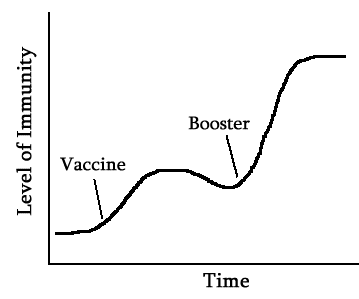Antigens and Pathogens
An antigen is anything that causes irritation to the body, causing it to react. This could be anything from pollen to a splinter to a virus. A pathogen is an antigen that causes a disease. The pathogens we typically think of are bacteria, fungi, and viruses.
Bacteria are microscopic, one-celled organisms that exist everywhere. The digestive tracts of all animals are colonized by bacteria, which aid in digestion by freeing up or creating nutrients. Some animals rely so heavily on their gut bacteria that they cannot digest properly without them. Normally these bacteria keep each other in check through competition, and do more good than harm. It is only when things get out of balance that these bacteria cause problems.
Of course, there are plenty of bacteria that are not native to the body. The skin usually provides an effective barrier against infection, but cuts and scrapes can allow bacteria to invade. Mucus membranes, like those in the mouth and sinus are also routes for infection. Bacteria can disrupt the body in a number of ways, but the most dangerous bacteria usually produce a toxin of some sort. These toxins may persist long after the bacteria themselves are dead. Food poisoning is often caused by bacterial toxins.
Fungi reproduce by making spores which can exist in the environment until they find a suitable place to colonize. Spores are virtually everywhere, and tend to survive longest in damp or humid locations. Frequent cleaning won't get rid of spores completely (bread will eventually go moldy no matter how clean your counter is), but it will reduce the number of spores in the environment. Healthy animals are capable of avoiding most fungal infections unless they are exposed to a very large numbers of spores.
Viruses are not classified as living organisms. They are basically wandering packets of genes that cannot reproduce on their own. Viruses usually attack a very specific type of cell within the host organism. They attach to the surface of the cell like a tiny moon lander and then inject their DNA. This DNA then combines with that of the cell, modifying it into a factory for making more viruses. The cell will fill up with virus parts until it explodes, releasing many more viruses into the body. Click here to see an animation.
One of the main problems with viruses is that they prevent cells from functioning normally. A good example of this is HIV. This virus attacks helper T cells, the body's first line of defense against infection. In a patient with HIV all these cells stop protecting the body and start making viruses instead. Patients with AIDS die from bacterial infections, pneumonia, and other diseases that would be relatively easy for a health human to recover from.
Antibiotics
Antibiotics are specific compounds which target bacteria. They have NO effect on viruses. These compounds should always be used with care; if used incorrectly, they can cause problems. The body is very carefully balanced. The goal of antibiotic treatment is to restore balance to an upset bodily system. Using one incorrectly may instead knock the body out of balance further.
Some antibiotics kill bacteria indiscriminately. This means that all those nice microorganisms in your digestive system may be killed as well. Not only could this impair digestion, but it leaves a vacant space for other organisms to take up residence. These new organisms may or may not be good for you. Some veterinarians will prescribe lactobacillus ("good" bacteria) if a bird needs repeated antibiotic treatments. This is to help replenish the bacteria killed off in the gut.
A common problem is that not everyone follows the directions. Antibiotics are not like Aspirin- you can't just stop taking them as soon as you feel better. Even if symptoms regress, the prescription must be followed to the letter. Stopping treatments too soon may leave some of the offending bacteria alive, particularly those which may be somewhat resistant, and these can rapidly multiply to troublesome numbers.
Vaccines 
The body's immune system is an amazing thing. After it recovers from an infection it "remembers" the invading organism- and it can recognize it again. Every cell or virus has proteins imbedded in its surface. These proteins act like markers which distinguish one pathogen from another. During and after an infection, the body produces antibodies against the pathogen that caused the infection. Antibodies have a very specific shape and will only bind to the pathogen they were designed for. When an antibody locates its target pathogen, it will bind to the surface and act like a flag. The body will then send cells to destroy the flagged pathogen.
A vaccination is made up of the very pathogen you want to prevent. The pathogen is either killed or modified so that it cannot reproduce. Once injected, the body recognizes the vaccine particles as being foreign, and antibodies are produced. A vaccine trains the body to recognize a specific pathogen before it get an infection.
The initial injection usually causes the body to respond, but not all that strongly. It often takes one or two doses (booster shots) to cause the body to really remember the pathogen and start cranking out antibodies. The chart shows how immunity is affected over time. Notice how the vaccine causes an initial boost, but then immunity starts to wear off. A booster shot, given at the appropriate time, causes a massive jump in immunity that lasts much longer.
Vaccines are in no way foolproof. Occasionally a modified-live vaccine can actually cause an infection or an allergic reaction. Vaccines made from killed organisms are safer, but they do not work as effectively because the body may not recognize a dead organism as a threat. Another problem is that some viruses, like HIV and the flu, mutate so fast that we cannot make vaccines fast enough to keep up with them. This is why a flu shot needs to be repeated every year. Each year there will be new strains of the virus.
